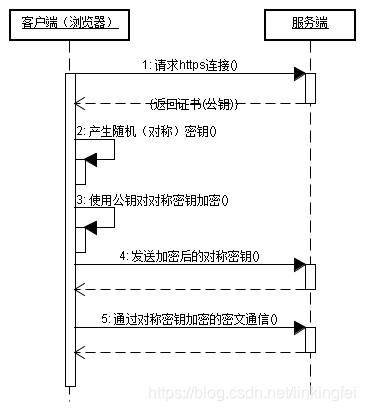1、http协议版本
http1.0:当前浏览器客户端与服务器端建立连接之后,只能发送一次请求,一次请求之后连接关闭。
http1.1:当前浏览器客户端与服务器端建立连接之后,可以在一次连接中发送多次请求。
2、GET与POST 区别
Get
- 地址栏(URI)会跟上参数数据。以?开头,多个参数之间以&分割。
- GET提交参数数据有限制,不超过1KB。
- GET方式不适合提交敏感密码。
- 注意: 浏览器直接访问的请求,默认提交方式是GET方式
POST方式提交
- 参数不会跟着URI后面。参数而是跟在请求的实体内容中。没有?开头,多个参数之间以&分割。
- POST提交的参数数据没有限制。
- POST方式提交敏感数据。
3、防止非法链接(referer)
过滤器或拦截器
String referer = req.getHeader("referer");
// 请求服务名称
String serverName = req.getServerName();
if (referer == null || !(referer.contains(serverName))) {
req.getRequestDispatcher("error.png").forward(req, res);
return ;
}
请求重定向(Location)
resp.setStatus(302);
resp.setHeader("Location", "OtherServlet");
Https与Http区别
1、https 协议需要到 ca 申请证书,一般免费证书较少,因而需要一定费用。
2、http 是超文本传输协议,信息是明文传输,https 则是具有安全性的 ssl 加密传输协议。
3、http 和 https 使用的是完全不同的连接方式,用的端口也不一样,前者是 80,后者是 443。
4、http 的连接很简单,是无状态的;HTTPS 协议是由 SSL+HTTP 协议构建的可进行加密传输、身份认证的网络协议,比 http 协议安全。
https工作原理
(1)客户使用 https 的 URL 访问 Web 服务器,要求与 Web 服务器建立 SSL 连接。
(2)Web 服务器收到客户端请求后,会将网站的证书信息(证书中包含公钥)传送一份给客户端。
(3)客户端的浏览器与 Web 服务器开始协商 SSL 连接的安全等级,也就是信息加密的等级。
(4)客户端的浏览器根据双方同意的安全等级,建立会话密钥,然后利用网站的公钥将会话密钥加密,并传送给网站。
(5)Web 服务器利用自己的私钥解密出会话密钥。
(6)Web 服务器利用会话密钥加密与客户端之间的通信。

https优缺点
(1)HTTPS 协议握手阶段比较费时,会使页面的加载时间延长近 50%,增加 10% 到 20% 的耗电;
(2)HTTPS 连接缓存不如 HTTP 高效,会增加数据开销和功耗,甚至已有的安全措施也会因此而受到影响;
(3)SSL 证书需要钱,功能越强大的证书费用越高,个人网站、小网站没有必要一般不会用。
(4)SSL 证书通常需要绑定 IP,不能在同一 IP 上绑定多个域名,IPv4 资源不可能支撑这个消耗。
(5)HTTPS 协议的加密范围也比较有限,在黑客攻击、拒绝服务攻击、服务器劫持等方面几乎起不到什么作用。最关键的,SSL 证书的信用链体系并不安全,特别是在某些国家可以控制 CA 根证书的情况下,中间人攻击一样可行。
服务器模拟http请求工具
/**
* 发送 post请求访问本地应用并根据传递参数不同返回不同结果
*/
public void post() {
// 创建默认的httpClient实例.
CloseableHttpClient httpclient = HttpClients.createDefault();
// 创建httppost
HttpPost httppost = new HttpPost("http://localhost:8080/myDemo/Ajax/serivceJ.action");
// 创建参数队列
List<NameValuePair> formparams = new ArrayList<NameValuePair>();
formparams.add(new BasicNameValuePair("type", "house"));
UrlEncodedFormEntity uefEntity;
try {
uefEntity = new UrlEncodedFormEntity(formparams, "UTF-8");
httppost.setEntity(uefEntity);
System.out.println("executing request " + httppost.getURI());
CloseableHttpResponse response = httpclient.execute(httppost);
try {
HttpEntity entity = response.getEntity();
if (entity != null) {
System.out.println("--------------------------------------");
System.out.println("Response content: " + EntityUtils.toString(entity, "UTF-8"));
System.out.println("--------------------------------------");
}
} finally {
response.close();
}
} catch (ClientProtocolException e) {
e.printStackTrace();
} catch (UnsupportedEncodingException e1) {
e1.printStackTrace();
} catch (IOException e) {
e.printStackTrace();
} finally {
// 关闭连接,释放资源
try {
httpclient.close();
} catch (IOException e) {
e.printStackTrace();
}
}
}
/**
* 发送 get请求
*/
public void get() {
CloseableHttpClient httpclient = HttpClients.createDefault();
try {
// 创建httpget.
HttpGet httpget = new HttpGet("http://www.baidu.com/");
System.out.println("executing request " + httpget.getURI());
// 执行get请求.
CloseableHttpResponse response = httpclient.execute(httpget);
try {
// 获取响应实体
HttpEntity entity = response.getEntity();
System.out.println("--------------------------------------");
// 打印响应状态
System.out.println(response.getStatusLine());
if (entity != null) {
// 打印响应内容长度
System.out.println("Response content length: " + entity.getContentLength());
// 打印响应内容
System.out.println("Response content: " + EntityUtils.toString(entity));
}
System.out.println("------------------------------------");
} finally {
response.close();
}
} catch (ClientProtocolException e) {
e.printStackTrace();
} catch (ParseException e) {
e.printStackTrace();
} catch (IOException e) {
e.printStackTrace();
} finally {
// 关闭连接,释放资源
try {
httpclient.close();
} catch (IOException e) {
e.printStackTrace();
}
}
}
 HTTP与HTTPS详解
HTTP与HTTPS详解





















 1559
1559

 被折叠的 条评论
为什么被折叠?
被折叠的 条评论
为什么被折叠?








